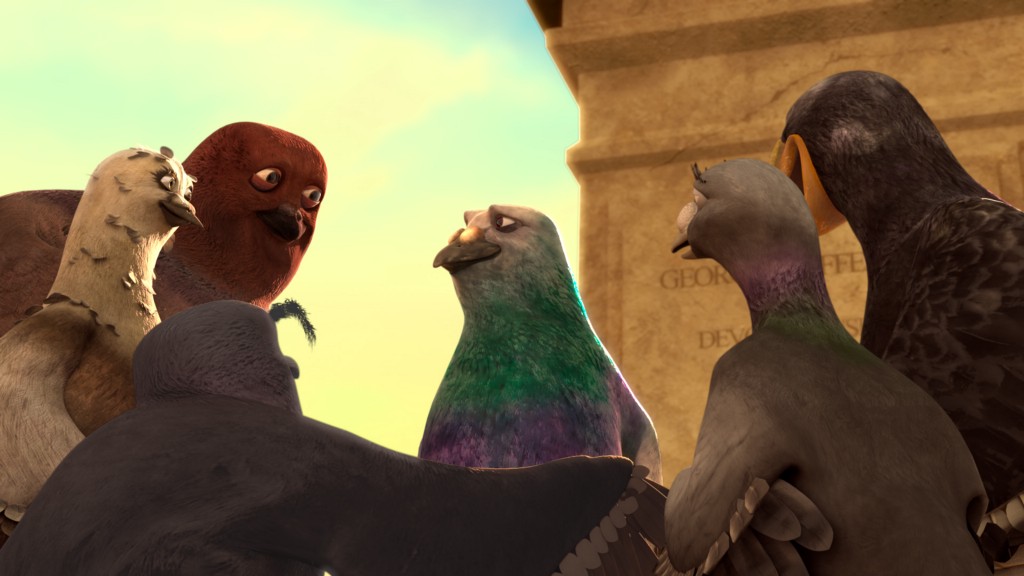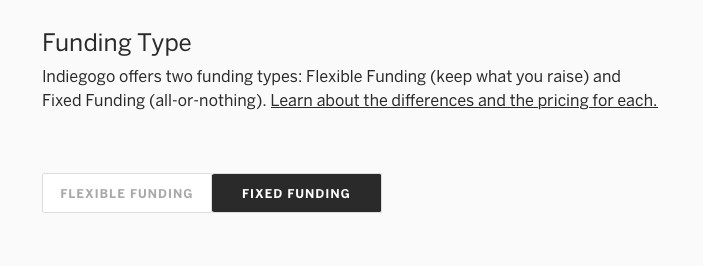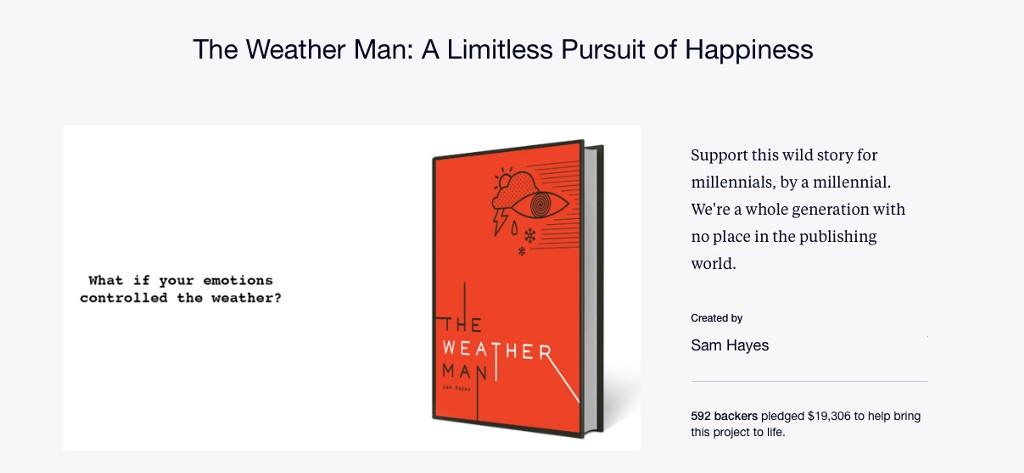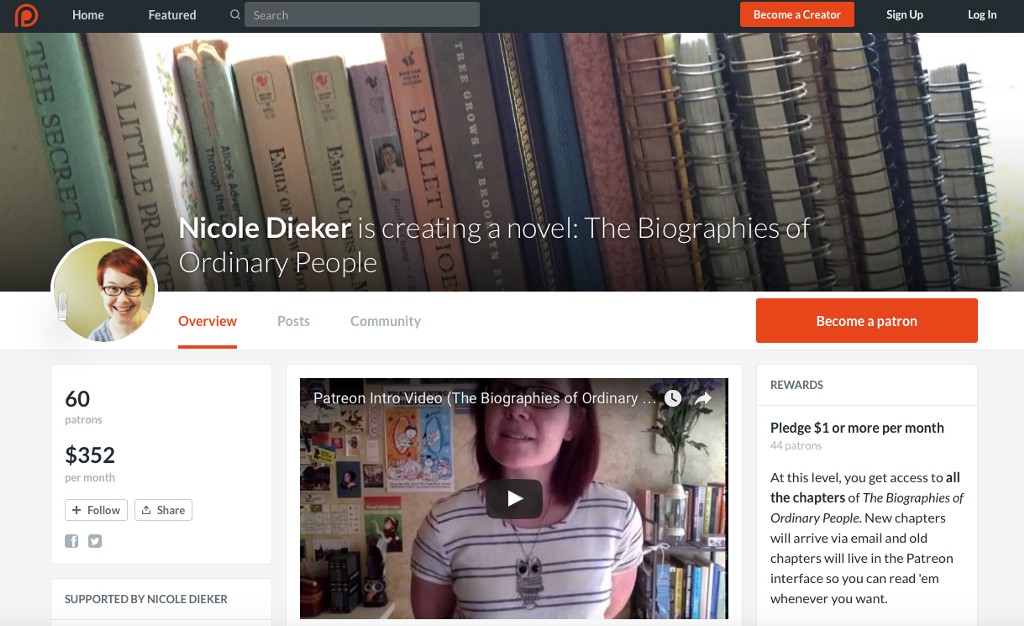Crowdfunding Your Creative Dreams
Because how else are you going to make them a reality?

No doubt there’s a bunch of frustrated artists out there in The Billfold community. Even for those of us who have “creative” jobs, there’s often a more arty, less-profitable project we’d rather be working on.
If you want to bring your creative dreams to life but don’t have the cash (or can’t justify the expense), crowdfunding could be the answer.
For some very lucky/talented/industrious people, crowdfunding can open the door to one of those highly coveted creative careers — you know, the ones where you get paid a decent amount to do exactly what you love and live happily ever after as a result.
Or for someone like Sam Hayes — a millennial who wrote a book for millennials and then got told by publishers that it was great, but millennials don’t buy books, so they wouldn’t publish it — crowdfunding is a way to kick that door in. His novel, The Weather Man, will be released November 15.

The Billfold’s very own Nicole Dieker is using Patreon’s recurring funding as a means of motivating and measuring the writing of her novel, The Biographies Of Ordinary People. I asked Nicole to explain why she chose Patreon, and here’s her response:
I’m looking at it as a way both to kick myself into actually doing this, to publicly commit to writing two chapters of a novel every week and to see if this story resonates with people to the point where they will contribute financially.
It’s sort of a win-win-win: I get to write this book, people who are interested in the story get to read it, and get this lovely metric that says “this many people like it,” so when it comes time to talk to agents and publishers, I can say “look, these people have already invested in this financially, thus more people may invest in it later.”
Animator Dmitry Milkin took the proof of concept in his graduate thesis project, Curpigeon, all the way to Boston Jewish Film Festival acceptance with the magic of crowdfunding.

Before you get too excited by these success stories, there is one major problem with crowdfunding: asking other people to give you money for the thing you really care about, but they almost certainly don’t care as much about, fails overwhelmingly.
Less Than a Third of Crowdfunding Campaigns Reach Their Goals
It’s ok, though. Crowdfunding strategist extraordinaire Kat Jenkins has some terrific advice to get you into the successful campaigner’s club with Sam, Nicole, and Dmitry. Kat has consulted on 50 projects, which have raised a combined total of $1.2M, and she has an 85 percent success rate (this is exceptionally good in the crowdfunding world, you should listen to her).
Get your ducks lined up
For starters, you need to figure out who’s going to support your creative dreams with actual money and not just cheers from the sidelines. You also need to give people something to get excited about, as well as evidence that you’re fully committed to the project. Here’s how Kat explained it to me:
Think about the type of people who will back you, and what their motivations for doing so are. This is a common marketing technique and a quick Google search of “Ideal Customer” will help put yourself in your backer’s shoes.
Show momentum. You need to have brought this project as close to completion as you can. Have your songs and scripts written. Know your dates, venues, costs, and team. Showing you have already started this, and you just need a little help is a better sell than “here’s something I want to do.”
Curpigeon’s polished preview is the perfect example of what inspires a supporter to pull out their wallet and give generously: high quality, clear vision, and a demonstrable level of dedication. In fact, the Curpigeon campaign pulled in almost twice as much as Dmitry had initially aimed for with a grand total of $9,280.
“I think people saw the quality of the film and really resonated with its socially conscious message,” Dmitry says. “So in short, the message and the production value is what stuck out to people.”
Here are a few more tips from Kat:
Finally, test it — find someone you know who already is the type of person you’d imagine would be interested in what you’re doing and ask for feedback. Tell them what you’re doing, how they can help, and what they get in return. Ask if they’re interested in supporting you, and if not, why? If their answers aren’t coming in as you expect, you need to tweak your campaign.
If you’re going for a one-off timed campaign like Kickstarter or Indiegogo, you also need to know your loved ones are ready to represent that love with dollars, quickly:
It’s vitally important that creators know they need to bring in 30 percent of their funds within the first week through their own sources (friends, family, fans). Once that’s secured, then they can reach out for wider promotion (media, social media, influencers etc.).
Higher risk, higher reward
If you’re opting for a one-off, timed campaign, your best bet is to go for all-or-nothing (fixed funding) rather than keep what you raise (flexible funding). Kat explains why:
Your fear will tell you to choose “flexible”, but you’re more likely to succeed if you choose “fixed”… Flexible funding for creative projects usually means you only raise part of the money you need, but you’re obliged to do what you promised.

Sam chose all-or-nothing because he felt it gave fence-sitting supporters more incentive to pledge. “It’s much better from a social media perspective for a call to action,” he says.
Stand out from the crowdfunding crowd
To get your campaign noticed, make a video. A good one. As Kat explains:
A video is work for you, but it’s a nice passive way to communicate what you’re planning to do to a potential backer. Use it to show who you are, and what the project will involve. Try to hook them using what you’ve learned about their motivations. SHOW them, as well as ‘tell’ them — just talking to the camera works, but you can get more creative than that as well. Keep it short and snappy — you want to capture attention immediately and have your video under 4 minutes.
It’ll increase your chances of success anywhere between 20 to 30 percent.
Sam’s video introducing The Weather Man was key to his campaign’s success — the short clip went wild on Facebook and got Sam’s project featured in Kickstarter’s Projects We Love.
“I put a lot of effort into the video. Even though it’s only a four-minute video, I worked on the script for weeks. People really loved the video; it got shared on Facebook over 100 times and … probably got viewed 25,000 times,” Sam says.
Sam’s video also likely captured people’s attention because of its message about millennials being “a whole generation with no place in the publishing world.”
“You can’t just sell them on I want to make this book and express myself,” he adds. “You need a vision that’s bigger than you or the book. You need to express that vision and why it’s important beyond just I want to accomplish my dreams.”
Working hard for the money
Crowdfunding isn’t a matter of having a brilliant idea, letting people know about it, then waiting for the pledges to roll in.
Sam raised a whopping $19,306 in 29 days — especially impressive given he was aiming for $10,200 — but he worked his backside off to get that much. “It takes over your life completely,” he says.

“With Kickstarter, most of the money that gets raised … is in the first two or three days and the last two or three days … In the middle, your community has seen your social media posts ten times already and they’re kinda tired of it,” Sam says. “I used that middle time to do the stuff to generate press and it ended up working really well.”
Between tweeting at magazines and putting up fake street signs about The Weather Man all over Los Angeles and Chicago, Sam managed to get write-ups about his project in LAist, LA Magazine, and the Chicago Tribune.
The Story Behind Those Fake Weather Signs Popping Up Around The City
Get creative about how you give back
For creative projects, there are plenty of ways to reward your supporters without eating into your funding (you’ll have platform fees and billing partner fees doing enough of that already). More great advice from Kat:
Generally speaking, go for low-cost digital or experiential rewards that are directly related to your project. Allow your backers ‘behind the curtain’ and make them fans of your project too.
Rewards like regular behind-the-scenes updates, a digital download, a PDF script, getting to name a character or location, a personalised video or answering machine message, ‘be an extra’ experiences, premiere/launch parties, and special credits cost you practically nothing to produce and distribute. They also help build excitement and a fandom.
The third type of reward is a physical reward. These can be great at high levels — particularly if they are personalized — but the postage alone can hurt you.
Nicole, whose campaign brings in $352 per month—a figure which, as stated on a Patreon livestream, is considered successful—gives her fans rewards like access to a monthly advice column and annotated chapters of her novel. Only at the highest level of support ($40+) does she give backers a coffee mug with “she made a home of words and will” hand-painted on it.
Nicole also sees rewarding her fans regularly as a way to stay connected with them and keep them excited about her project.

Now that your crowdfunding curiosity has been piqued…
If you want more information on how to run a successful campaign, Kat has compiled a gigantic list of resources:
The Internet’s Greatest Crowdfunding Resources
She also offers some valuable insights into why campaigns fail:
Why Your Crowdfunding Project Is Failing
And here is a piece by yours truly with more from Kat and successful crowdfunders, as well as some info on four of the major platforms:
How to Choose the Perfect Crowdfunding Site For Your Side Project
Emily Friedel is a freelance writer based in Victoria, Australia, who doesn’t have any ideas worthy of crowdfunding just yet, but when she does she’ll be sure to let you know. You can follow her on Twitter via @ej_friedel.
Support The Billfold
The Billfold continues to exist thanks to support from our readers. Help us continue to do our work by making a monthly pledge on Patreon or a one-time-only contribution through PayPal.
Comments